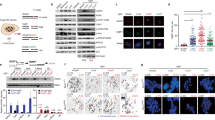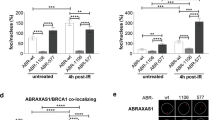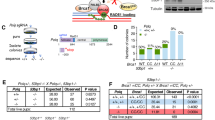Abstract
Heterozygosity for mutations in the BRCA1 gene in humans confers high risk for developing breast cancer, but a biochemical basis for this phenotype has not yet been determined. Evidence has accumulated implicating BRCA1, in the maintenance of genomic integrity and the protection of cells against DNA double strand breaks (DSB). Here we present evidence that human cells heterozygous for BRCA1 mutations exhibit impaired DNA end-joining, which is the major DSB repair pathway in mammalian somatic cells. Using an in vivo host cell end-joining assay, we observed that the fidelity of DNA end-joining is strongly reduced in three BRCA1+/− cell lines in comparison to two control cell lines. Moreover, cell-free BRCA1+/− extracts are unable to promote accurate DNA end-joining in an in vitro reaction. The steady-state level of the wild type BRCA1 protein was significantly lower than the 50% expected in BRCA1+/− cells and thus may underlie the observed end-joining defect. Together, these data strongly suggest that BRCA1 is necessary for faithful rejoining of broken DNA ends and that a single mutated BRCA1 allele is sufficient to impair this process. This defect will compromise genomic stability in BRCA1 germ-line mutation carriers, triggering the genetic changes necessary for the initiation of neoplastic transformation.
This is a preview of subscription content, access via your institution
Access options
Subscribe to this journal
Receive 50 print issues and online access
$259.00 per year
only $5.18 per issue
Buy this article
- Purchase on Springer Link
- Instant access to full article PDF
Prices may be subject to local taxes which are calculated during checkout



Similar content being viewed by others
References
Abbott DW, Thompson ME, Robinson-Benion C, Tomlinson G, Jensen RA, Holt JT . 1999 J. Biol. Chem. 274: 18808–18812
Baumann P, West SC . 1998 Proc. Natl. Acad. Sci. USA 95: 14066–14070
Blagosklonny MB, An WG, Melillo G, Nguyen P, Trepel JB, Neckers LM . 1999 Oncogene 18: 6460–6468
Chen J, Silver DP, Walpita D, Cantor SB, Gazdar AF, Tomlinson G, Couch FJ, Weber B, Ashley T, Livingston DM, Scully R . 1998 Mol. Cell. 2: 317–328
Deng C-X, Scott F . 2000 Oncogene 19: 1059–1064
Escarceller M, Buchwald M, Singleton BK, Jeggo PA, Jackson SP, Moustacchi E, Papadopoulo D . 1998 J. Mol. Biol. 279: 375–385
Essers J, van Steeg H, de Wit J, Swagemakers SMA, Vermeij M, Hoeijmakers JHJ, Kannars R . 2000 EMBO J. 19: 1703–1710
Foray N, Randrianarison V, Marot D, Perricaudet M, Lenoir G, Feunteun J . 1999 Oncogene 18: 7334–7342
Goven LC, Avrutskaya AV, Latour AM, Koller BH, Leadon SA . 1998 Science 281: 1009–1012
Haber JE . 2000 Trends. Genet. 16: 259–264
Hall JM, Lee MK, Newmann B . 1990 Science 250: 1684–1689
Jeggo PA . 1998 Radiat. Res. 150: S80–S90
Karran P . 2000 Curr. Opin. Gene. Dev. 10: 144–150
Lee MS, Wajnrajch PW, Kim SS, Plotnick LP, Wang J, Gertner JM, Leibel RL, Dannies PS . 2000 Endocrinology 141: 883–890
Le Page F, Randrianarison V, Marot D, Cabannes J, Perricaudet M, Feuteun J, Sarasin A . 2000 Cancer Res. 60: 5548–5552
Miki Y, Swensen J, Shattuck-Eidens D, Futreal PA, Harshman K, Tavigian S, Liu Q, Cochran C, Bennett LM, Ding W . 1994 et al Science 266: 66–71
Moynahan ME, Chiu JW, Koller BH, Jasin M . 1999 Mol. Cell. 4: 511–518
Paull TT, Rogakou EP, Yamazaki V, Kirchgessner CU, Gellert M, Bonner WM . 2000 Curr. Biol. 10: 886–895
Paull TP, Cortez D, Bowers B, Elledge SJ, Gellert M . 2001 Proc. Natl. Acad. Sci. USA 98: 6086–6091
Petrini JHJ . 1999 Am. J. Hum. Genet. 64: 1264–1269
Pluth JM, Fried LM, Kirchgessner CU . 2001 Cancer Res. 61: 2649–2655
Puget N, Stoppa-Lyonnet D, Sinilnikova OM, Pages S, Lynch HT, Lenoir GM . 1999 Cancer Res. 59: 455–461
Rogakou EP, Pilch DR, Orr AH, Ivanova VS, Bonner WM . 1998 J. Biol. Chem. 273: 5858–5868
Rogakou EP, Boon C, Redon C, Bonner WM . 1999 J. Cell. Biol. 146: 905–916
Rothfub A, Schütz P, Bochum S, Volm T, Eberhardt E, Krienberg R, Vogel W, Speit G . 2000 Cancer Res. 60: 390–394
Scully R, Chen J, Plug A, Xiao Y, Wever D, Feunteun J, Ashley T, Livinston DM . 1997 Cell 88: 265–275
Scully R, Ganesan S, Vlasakova K, Chen J, Sokolovsky M, Livigston DM . 1999 Mol. Cell 4: 1093–1099
Shen SX, Weaver Z, Xu X, Li C, Weinstein M, Chen L, Guan XY, Ried T, Deng CX . 1998 Oncogene 17: 3115–3124
Smith J, Andrau JC, Kallenbach S, Laquerbe A, Doyen N, Papadopoulo D . 1998 J. Mol. Biol. 281: 815–825
Smith J, Baldeyron C, De Oliveira I, Sala-Trepat M, Papadopoulo D . 2001 Nucleic Acid Res. 29: 4783–4792
Stoppa-Lyonnet D, Laurent-Puig P, Essioux L, Pages S, Ithier G, Ligot L, Fourquet A, Salmon RJ, Clough KB, Pouillart P, Bonaiti-Pellie C, Thomas G . 1997 Breast Cancer Group. Am. J. Hum. Genet. 60: 1021–1030
Wang Y, Cortez D, Yazdi P, Neff N, Elledge SJ, Qin J . 2000 Genes Dev. 14: 927–939
Wang H, Zeng Z-C, Bui T-A, DiBiase SJ, Qin W, Xia F, Powell SN, Iliakis G . 2001 Cancer Res. 61: 270–277
Welcsh PL, Owens KN, King MC . 2000 Trends Genet. 16: 69–74
Wilkie AOM . 1994 J. Med. Genet. 31: 89–98
Yamane K, Katayama E, Tsuruo T . 2000 Biochem. Biophys. Res. Commun. 279: 678–684
Zhong Q, Chen C-F, Li S, Chen Y, Wang C-C, Xiao J, Chen P-L, Sharp ZD, Lee W-H . 1999 Science 285: 747–750
Acknowledgements
We specially thank Dr SC West (Imperial Cancer Research Fund, Clare Hall Laboratories, UK) and Dr N Doyen (URA1960 CNRS, Institut Pasteur, France) for their critical comments and valuable suggestions and Dr J Couturier and D Rouillard for their contribution. We are grateful to Dr E Moustacchi and Dr G Almouzni for helpful discussions and critical readings of the manuscript. This work is supported by the Centre National pour la Recherche Scientifique, and grants from Association pour la Recherche sur le Cancer, Commission of European Community and Ministére de l'Education Nationale et de la Recherche. J Smith was a recipient of a Fellowship from, Ligue Nationale Française contre le Cancer and Institut Curie-Research Division. C Baldeyron, C Jacquemont and S Gad were recipient of Fellowships from the Ministère de l'Education Nationale et de la Recherche.
Author information
Authors and Affiliations
Corresponding author
Rights and permissions
About this article
Cite this article
Baldeyron, C., Jacquemin, E., Smith, J. et al. A single mutated BRCA1 allele leads to impaired fidelity of double strand break end-joining. Oncogene 21, 1401–1410 (2002). https://doi.org/10.1038/sj.onc.1205200
Received:
Revised:
Accepted:
Published:
Issue Date:
DOI: https://doi.org/10.1038/sj.onc.1205200
Keywords
This article is cited by
-
Reduced BRCA1 transcript levels in freshly isolated blood leukocytes from BRCA1 mutation carriers is mutation specific
Breast Cancer Research (2016)
-
Haploinsufficiency for BRCA1 leads to cell-type-specific genomic instability and premature senescence
Nature Communications (2015)
-
BRCA1 mRNA levels following a 4–6-week intervention with oral 3,3′-diindolylmethane
British Journal of Cancer (2014)
-
DNA double-strand break repair genotype and phenotype and breast cancer risk within sisters from the New York site of the Breast Cancer Family Registry (BCFR)
Cancer Causes & Control (2013)
-
Ionizing radiation or mitomycin-induced micronuclei in lymphocytes of BRCA1 or BRCA2 mutation carriers
Breast Cancer Research and Treatment (2011)



